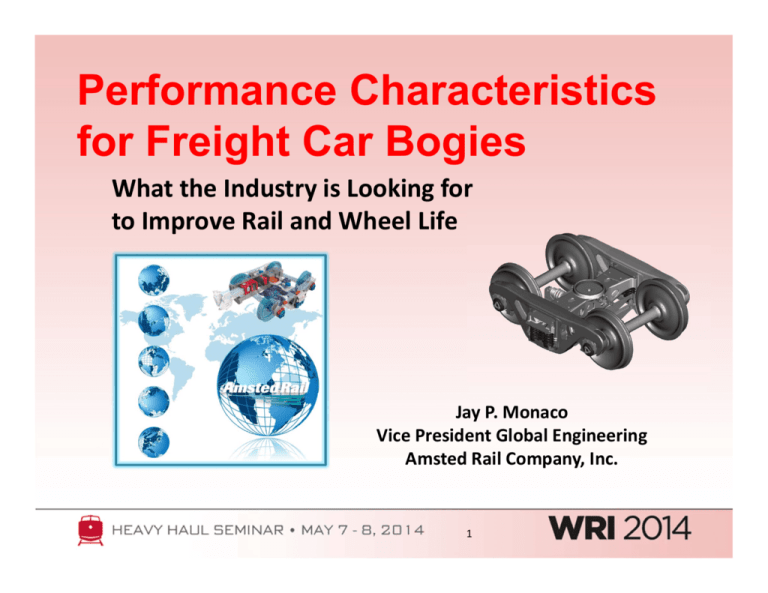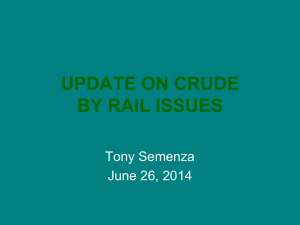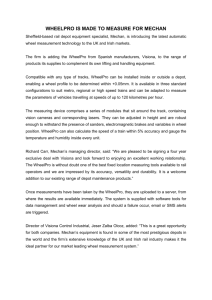Performance Characteristics for Freight Car Bogies
advertisement

Performance Characteristics for Freight Car Bogies What the Industry is Looking for to Improve Rail and Wheel Life Jay P. Monaco Vice President Global Engineering Amsted Rail Company, Inc. 1 Demand for Productivity Capacity increases through… • Longer trains • Heavier axle loads 25.0 t 27.5 t 30.0 t 32.5 t 37.5 t • Increased train velocity • More lading capacity, lighter railcars Increase sensitivity to… • Load balance and vehicle stability • Speed and track conditions • Railcar construction Increasingly demanding operating environment 2 40 + Component Attributes Long life / low maintenance / reduced wear…and… Quality / integrity / reliability • Reduced incidence of in‐service failures ‒ Safety / security / service reliability ‒ System capacity and efficiency • Maximum uptime ‒ Asset utilization / train velocity ‒ Productivity Component performance is critical to wheel and rail life 3 Key Running Gear Components Bogie and Braking Systems End of Car Systems Optimize the systems! Railcar running gear components work together as a system 4 Wheel / Rail Interaction Suspension, vehicle and track are a system 5 Demands on Bogie System Make wheels last longer Eliminate bearing failures Reduce system maintenance Reduce system weight … but service loads are increasing ! 6 Bogie System Weight Variation Bogie Castings, Stabilizers, Load Coils for 286,000 lb. GRL Average Carset weight across all designs = 7,857 lbs. 800 lbs. difference Lower weight components = more carrying capacity 7 Dynamic Performance Yaw & Sway Car / Suspension Specific Twist & Roll 15‐25, 50‐60 mph Pitch & Bounce 50‐70 mph Truck Hunting Truck Warp, Truck Rotation, Wheelset Movement 40+ mph 8 Bogie Performance Evolution More demanding environment Bogie system performance AAR Specification M‐976 Steering Curve negotiation without compromising high speed stability Suspension M‐976 Bogie System Reduced wheel and track wear Damping of vertical and lateral inputs; bogie squaring Reduced impact of loading conditions 9 M-976 Test Regimes Loaded Short Car 4427 cu. ft. Empty Short Car 4427 cu. ft Test Regime Covered Hoppers: • Empty / Loaded • Short / Long Hunting Empty - Short Steady State Curving Empty - Short Loaded - Short Curve Resistance Loaded – Short Spiral Empty - Short Loaded - Short Empty - Long Twist / Roll Empty - Short Loaded - Short Pitch / Bounce Empty - Short Loaded - Short Yaw / Sway Loaded - Short Dynamic Curving Loaded - Short Major_modes_qt.mov Empty Long Car 6000 cu. ft. 10 M-976 Test Regimes Hunting Criteria • • Maximum Lateral Acceleration: 1.5 g’s peak to peak Standard Deviation: 0.13 g’s rms Steady State Curving • • 95th percentile Maximum Wheel L/V: 0.8 95th percentile Maximum Axle Sum L/V: 1.5 11 M-976 Test Regimes Curving Resistance • • • • • Average Pounds \ Ton \ Degree: 0.4 maximum 1.5 Degree Curve 4.0 Degree Curve 7.5 Degree Curve 10 Degree Curve Pitch / Bounce • Minimum Vertical load: 10% • Dynamic Acceleration: 1.0 g • Spring Capacity Maximum: 95% 12 M-976 Test Regimes Twist / Roll • • • • Max. Axle Sum L/V: 1.5 Min. Vertical Load: 10% Dynamic Acceleration: 1.0 g Spring Capacity Maximum: 95% Yaw / Sway • • Maximum Truck Side L/V: Maximum Axle Sum L/V: 0.7 1.5 13 M-976 Test Regimes Dynamic Curving • • • Minimum Vertical load: 10% Maximum Wheel L/V: 1.0 Maximum Axle Sum L/V: 1.5 And if that wasn’t enough… 14 SRI 2A – Integrated FC Truck New test regimes being considered • Loaded Car Hunting ‒ Same criteria as empty car hunting ‒ Using loaded 5160 c.f. grain car ‒ > 75 mph • Curving Resistance ‐ Low Rail Traction Ratio (T/N) ‒ Vertical, lateral and longitudinal forces at contact patch ‒ Using instrumented wheel set measurements ‒ T/N < 0.37 Traction Ratio < 0.37 = magic number to alleviate RCF 15 Low Rail Traction Ratio vectored longitudinal force (taking tread taper into account) T/N = vectored lateral force (taking tread taper into account) at the contact patch 16 Key Bogie Components Stability / hunting control • Friction wedges; squaring; dimension control • Center bowl liner (loaded car) – rotational resistance / friction damping (too low = stability issues) • Side bearings (light car) – rotational resistance / friction damping; railcar roll control Reduced rolling resistance • Low torque bearings • Passive steering components 17 Steering and Stability Steering = axle movement to negotiate curves • Elastomeric pad and special adapter enable steering • Pad deflects in shear with controlled stiffness (too stiff = harder on wheel; too soft = hunting / stability issues) • Stored pad energy restores axle on tangent track • Standard metal adapters can stick due to friction, causing wheel / flange scrubbing Curving vs. Stability… • Passive mechanical system is a compromise • Balance curving resistance and high speed stability …and remember vertical performance 18 Lateral and Longitudinal Motions 19 Lateral and Longitudinal Motions 20 Lateral and Longitudinal Motions 21 Findings Softer pad material = higher deflections Stiffer pad material = lower deflections • Less energy input • Less movement per unit of force • Increase in hunting threshold Alternatives exist to mitigate hunting and associated wheel tread scrubbing Squaring mechanism such as transom, spring plank or bracing helps with curving and stability, but adds cost and maintenance issues 22 High Speed Stability 3‐piece truck vs. alternative truck 23 Next Generation M-976 (?) AAR/TTCI (with supplier input) determining next level of achievable performance through SRI 2A • New specification to implement lessons learned • Test values expected to be tightened • Cost / benefit analysis to be undertaken before implementation; may be 3 + years out “One size fits all” philosophy to deal with any encountered conditions and car types forces design optimized for test conditions 24 High-mileage Tank Cars – Crude Oil Production surge required rail transport • • • Largest source = Bakken Shale reserves ND (~ 2/3 of which is shipped by rail) 2009: 11,000 crude oil car loads 2013: 400,000 crude oil car loads (estimated) Many unit trains in crude oil service • • 286,000 pounds GRL = 31,800 gallons crude oil > 100 cars and > 1.0 mile in length Currently ~ 10% crude oil shipped by rail • • • Unit trains account for 70% of crude oil rail shipment 2010: 207 unit trains dispatched 2012: 1,775 unit trains dispatched Production has exceeded pipeline capacity 25 Current Tank Car Fleet 335,000 tank cars in today’s fleet • • • 228,000 are DOT‐111 92,000 DOT‐111 are used to transport flammable liquid 14,000 are built to latest industry standard (CPC‐1232) ~30% of crude oil tank cars are built to the latest industry standard (CPC‐1232) A mix of pipeline and rail will always be necessary • Pipeline permitting takes years to get through Federal, State and local authorities; land acquisitions take time • Rail is flexible and can transport crude according to market demand and refinery efficiency 26 Existing DOT-111 Tank Cars Retrofit or aggressive phase out possible • ~78,000 DOT‐111 cars would need this • ~14,000 DOT‐111 may need additional upgrades Safety is main concern Wheel / Rail Interaction • • • Key to rail safety Alleviate RCF Eliminate failure modes 27 Maintenance Heavier loads and longer trains increase demands placed on railcar equipment (wear and tear) Running gear selection can mitigate effects … but, to keep assets moving safely… Inspection is required to determine repairs, and/or • Preventive (scheduled) maintenance • Corrective (reactive) maintenance • Setouts via wayside detectors, or alternative An effective maintenance program is essential Asset utilization / uptime vs. Safety / security vs. Maintenance 28 Real-time Asset Monitoring GPS location / speed / “active” asset time Evaluate system status and condition with sensors Impact on maintenance: • Preventive (scheduled) vs. Corrective (reactive) • Consider pre‐emptive maintenance 29 Condition Based Maintenance Preventive maintenance may prevent some failures, but premature failures can still occur; cost is high Corrective maintenance promises lower costs, but cost of reaction to failures is high CBM strategy • Can be effected using Rail Wayside Detection technology or On‐board Wireless Sensor technology • Lower operating costs; extend useful life of equipment • Increase productivity and maximize asset uptime • Measure / analyze real‐time; relay message to effect pre‐ emptive maintenance or repair (before a failure occurs) CBM strategy enables pre‐emptive maintenance 30 ISO 13374 Advisory Generation (AG) CBM Prognostic Assessment (PA) Predict Health Assessment (HA) Alert Alarm Data Manipulation (DM) Sensors Infer future health (life expectancy) Infer current health (condition) from key metrics Use metrics for condition assessment State Detection (SD) Data Acquisition (DA) Condition Based Maintenance $$$ Observe acceptable thresholds Calibrate, process, analyze Status A/D conversion, sampling frequency Pick up a copy of ISO13374 for some late night reading… 31 Increasing Maintenance Value $$$ Condition Monitoring and Diagnostics of Machines On-board Wireless Sensing Hatch open Hot bearing Wheel impact Bearing condition Door open Acceleration Handbrake set Bearing remaining life Real‐time information to keep trains moving safely 32 Onboard System approach Onboard wireless sensors and preprocessing of data Action messaging via satellite and/or cellular comm. Maintenance only when necessary Alarms GPS Data Instructions CMU Web portal 33 Wireless Sensor Applications Impact sensing (g’s) Handbrake status Hatch / Gate open Railcar weight Temperature Pressure Bearing condition 34 Case Study: Ride Quality Lateral Impact waveforms from website Vertical Longitudinal Measure impact acceleration Send alert when pre‐defined threshold is exceeded Capture location, date and time of impact View data on fleet management dashboard 35 Case Study: Temperature Track temperature of crude oil in near real‐time to determine need to steam cars Temperature changes based on commodity, car type and season can reduce heating and cooling costs Alert on criteria including rapid temperature change and crossing of absolute values 36 Case Study: Onboard Load Weigh Measure railcar weight directly – alternative to flow rate, etc. CMU Monitor weight during loading to improve accuracy WSN Alternative to trackside scales Maximize loadings and minimize overloaded conditions to avoid penalties Alert to return asset after unloading 37 Case Study: Handbrake Monitor Monitor linkage tension and report status wirelessly to CMU Alert when handbrake is applied and motion is detected to identify time and location of potential wheel damage Monitor and audit operational rule compliance: Behavioral change and Real‐time status to avoid accidents Safety and security through compliance monitoring and real time status 38 Technology Advancement Advance through technology to avoid failures and enhance productivity 39







